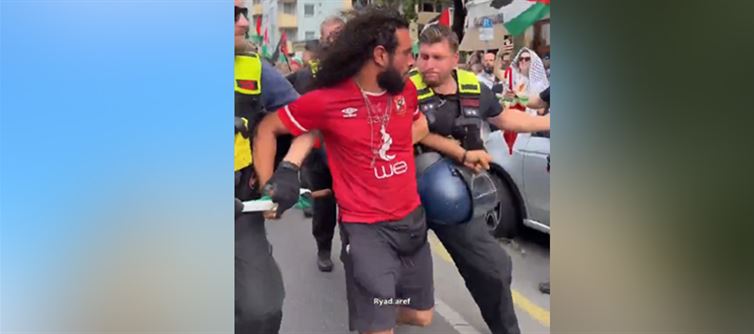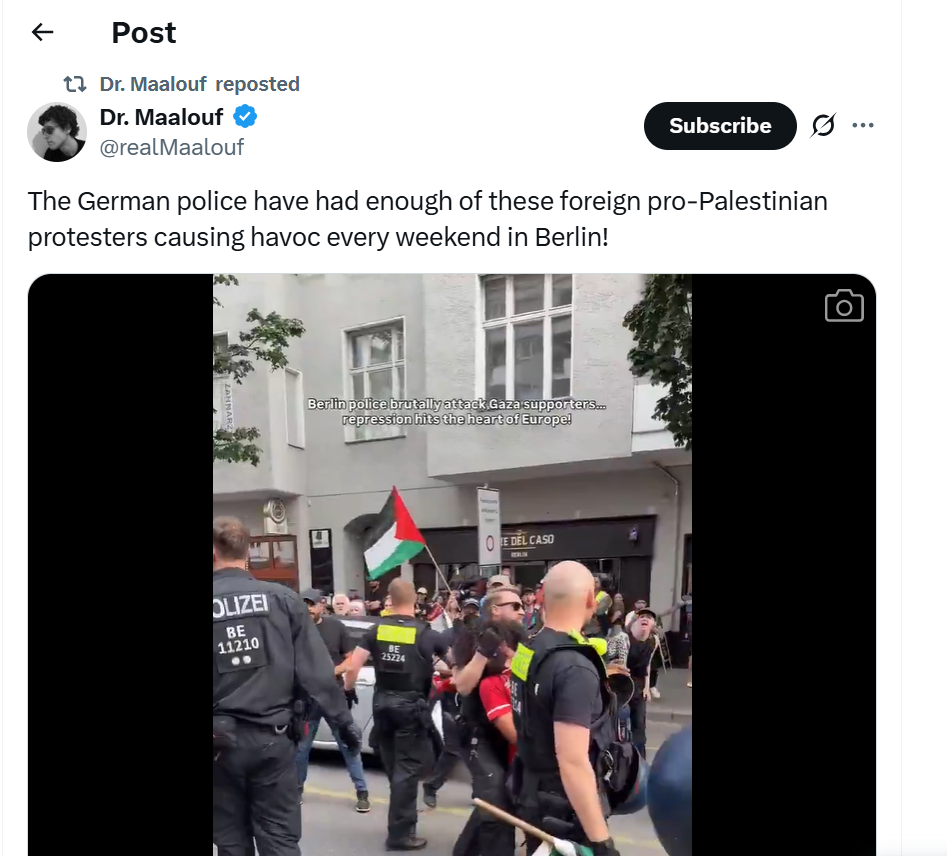
The video, sourced from the account @ryad_arif, shows a chaotic scene on a Berlin street. German police officers, identifiable by their uniforms and high-visibility vests, are seen forcibly detaining a protester. The individual, wearing a red shirt and black shorts, is being restrained by multiple officers, with one officer holding his head down and another gripping his arm. The background reveals a crowd of people, some holding Palestinian flags, indicating the nature of the protest.
 The text overlay in the video reads, "Berlin police brutally attack Gaza supporters... repression hits the heart of Europe," suggesting that the protesters view the police action as an aggressive response to their demonstration in support of Gaza. The presence of police vehicles and additional officers in the vicinity indicates a significant law enforcement presence, likely in anticipation of potential unrest.
The text overlay in the video reads, "Berlin police brutally attack Gaza supporters... repression hits the heart of Europe," suggesting that the protesters view the police action as an aggressive response to their demonstration in support of Gaza. The presence of police vehicles and additional officers in the vicinity indicates a significant law enforcement presence, likely in anticipation of potential unrest.The protest occurs against the backdrop of heightened global attention to the Israeli-Palestinian conflict, particularly concerning the situation in Gaza. Pro-Palestinian demonstrations have been frequent in european cities, including Berlin, as part of a broader movement advocating for Palestinian rights and condemning perceived injustices. These protests often draw large crowds and can become contentious, especially when they intersect with local laws and public order concerns.
Berlin, as a major european city with a diverse population, has been a focal point for such demonstrations. The German government’s stance on the Israeli-Palestinian issue, combined with domestic policies on public assembly and security, shapes the response to these protests. The video’s depiction of police action aligns with reports of increased police presence and occasional clashes during similar events, reflecting the delicate balance between maintaining order and respecting protest rights.
The video has sparked a range of reactions on social media. Dr. Maalouf’s post, which frames the event as an example of police overreach, has resonated with some users who express solidarity with the protesters and criticize the police response. Comments on the X thread include comparisons to other global protests and discussions about the role of law enforcement in managing dissent.
The incident raises questions about the legal framework governing protests in Germany. German law allows for freedom of assembly, but this right can be restricted if there is a threat to public order or safety. The use of force by police is also regulated, requiring proportionality and necessity. The video’s portrayal of the arrest suggests a potential area for scrutiny regarding whether these principles were adhered to.
Moreover, the event occurs in the context of broader european discussions about managing protests related to the Middle east conflict. Cities across Europe, including london and Paris, have seen similar demonstrations, often leading to debates about police tactics, protester rights, and the influence of international politics on domestic affairs.
This clash in Berlin is part of a larger narrative about the intersection of global conflicts and local politics. The Israeli-Palestinian issue, while distant geographically, has significant reverberations in european cities with diverse populations and strong diaspora communities. The presence of Palestinian flags and the nature of the protest indicate a transnational solidarity movement, which can both unite and divide local communities.
The incident also highlights the challenges of policing in multicultural societies. Law enforcement agencies must navigate complex cultural dynamics, ensuring public safety while avoiding perceptions of bias or excessive force. The video’s circulation on social media amplifies these challenges, as it shapes public perception and can influence policy responses.




 click and follow Indiaherald WhatsApp channel
click and follow Indiaherald WhatsApp channel